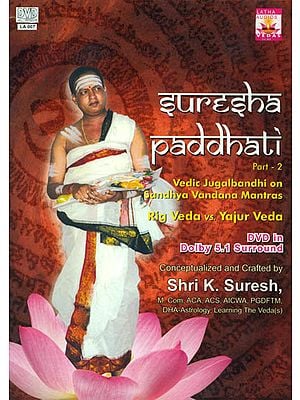
The Yajur Veda serves as a guide for the priests to perform sacred rituals like Ashvamedh or Rajasuya. Vajasaneyi is the most prominent branch of knowledge found in the Yajurveda. However, now only seven branches are found. Originally, the Yajur Veda contained 109 branches of knowledge. In fact, Yajurveda contains different levels of knowledge and wisdom. The Yajur Veda has been described as the “Veda of Rituals.” It contains about 1975 verse-mantras set in 40 chapters that had been used in ritual sacrifices by the Adhvaryu priest. This Vedic text also proves a useful source of information for agriculture, social, as well as economic life during the Vedic period. Most of the gods that are found in Rig Veda are also found here, such as Rudra and Uṣas.
Madhyandina Recension: Saunaka, Harisvāmin, Uraṭa, Gauradhara, and Mahīdhara. Kanva Recension: Sāyaṇa, Ānanda bodha, Anantācārya, Kālanātha, Murārimiśra, Halāyudha, Aditya-darśana, Devapāla, and Somānanda-putra. The commentators on the Shukla Yajurveda are as follows: The following are the commentators on the Krsna Yajur Veda: The oldest Yajurveda Samhita is known to be the Maitrayani Samhita that has survived. The Taittiriya Samhita is considered to be the best part of Yajur Veda. It is used during auspicious ceremonies and occasions. One of the most popular hymns from Yajurveda is the Gayatri Mantra that is popular even to this day. The two major sacrifices that are described in the Yajurveda relate to Ashvamedh and Darsapurnamasa. These Yajur Veda Samhita give a detailed description of sacrifices.įor example, there are vivid descriptions of many important sacrifices like Agnihotra, Vajapeya, Pitrimedha, Ashvamedh, Somayaga, Sarva-Medha, Sautramani, and so on. Maitrayani Samhita: It includes 6 Sub-recensions, 4 Kanda, and 54 Prapathakas. Kathaka Samhita: It includes 12 Sub-recensions, 5 Kanda, 40 Prapathakas, and 3093 Mantras. Kapishthala Samhita: It includes 5 Sub-recensions, 6 Kanda, and 48 Prapathakas. Taittiriya Samhita: It contains 2 Sub-recensions, 7 Kanda, and 42 Prapathakas. On the other hand, Krsna Yajurveda includes four Samhitas that are available today in the form of: Kanva Samhita: It contains 40 Adhyāyas, 328 Anuvakas, and 2086 verses. Madhyandina Samhita: It contains 40 Adhyāyas, 303 Anuvakas, and 1975 verses. Shukla Yajur Veda includes two Samhitas that are available today in the form of: So, this Yajurveda was named as Shukla or Vajasaneyi. Yajyavalkya prayed to the Sun, who descended in the form of a horse and returned him the Yajus. So, the Yajus became dark and was named as Krsna or Taittiriya. Yajyavalkya then vomited the Veda that he had learned from Sage Vaishampayana with the power of Yoga, and the other pupils swallowed up the Yajus, thus vomited and assumed the form of birds known as Tittri. However, once Vaishampayana became angry with Yajyavalkya and instructed him to give back what he had learned. Sage Vaishampayana had taught the Yajurveda to Rishi Yajyavalkya and other pupils. There’s a story given by Mahidhara that relates to the two-fold division of the Yajur Veda. The black Yajur Veda has survived in the form of four recensions into modern times. It implies the “un-arranged & un-clear” collection of verses in Yajur Veda. On the other hand, the Black Yajurveda contains instructions for sacrificial rituals. The White Yajur Veda has survived in the form of two recensions into modern times. It implies “well-arranged & clear” Yajur Veda. The White Yajurveda contains prayers and specific instructions for performing devotional sacrifices. The Black Yajur Veda known as Krsna or Dark. The White Yajur Veda known as Shukla or Pure. The Yajur Veda has been divided into two parts: 
Yajur Veda is believed to have been composed around 1200 to 1000 BCE. It can help you attain higher forms of happiness, including Moksha, Nirvana, or immortality. It helps to lead a life that is both meaningful and satisfying. The veda brings together the cosmic energies within oneself. So, Yajurveda seeks to awake your inner consciousness to open up new avenues of learning and understanding life and existence. It sets forth a yogic practice to purify both the body as well as the mind. On a deeper level, Yajurveda seeks to create consciousness among people. The Yoga teachings that are found in the Yajurveda are referred to as Vedic Yoga. It also details the principles of Pranayama and asana practice. Moreover, a large part of this Vedic text is devoted to ritual instruments & offerings that relate to certain aspects of Brahman or God.

It mainly deals with sacrificial rituals. So, Yajur Veda is a prayer-book for the Adhvaryu priest. This is a guide-book for the Adhvaryu priest for doing all ritualistic works in a sacrifice. It was the main Vedic script that was used by the priests in ancient India.






 0 kommentar(er)
0 kommentar(er)
